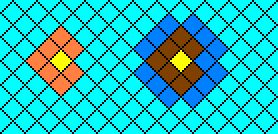Personally, I'd favor one-tile planets, for a number of reasons.
First, on any planet larger than this:
there are tiles onto which you
cannot land troops from space. While larger planets may allow some actual maneuvering of ground forces to attack, such maneuvering is effectly pointless when there are gigantic ships that can rain turbolaser fire from orbit. While the movies certainly don't apply any military principles, they do illustrate something accurately - most battles would either be low-level guerrilla warfare on an enemy-controlled planet (which Civ3 can't model effectively) or single, large-scale confrontations between armies that are resolved in one battle. The reason for this is simple: the only thing preventing the side with space superiority from simply destroying enemy forces from orbit is unwillingness to inflict whatever collateral damage would result. In TESB, they could have brought down the Hoth shield from orbit, but the bombardment required to do so would have also flattened everything under the shield, including Luke. So the use of ground troops was to take out the shield, after which the Imperials have won even without having superior ground forces, because they don't have to worry (as much) about collateral damage.
(Enter planetary ion cannon to break the blockade.)
Thus land battles are for control of whatever installations on the ground prevent orbital bombardment, and as soon as the attacker destroys or gains control of such installations, he wins. Of course, urban areas could hold out more effectively, but it would be permanently under siege.
Now, this has established that it's preferable to be no larger than the picture above, but that's not an argument for
one-tile planets. In fact, the four- or eight-tile planets have the advantage that they can represent control of the non-urban areas. (Of course, for a planet like Coruscant this would be bad, since there ARE no non-urban areas.) In addition, they allow multiple resources per planet, and varied terrain. This, I think, is a
disadvantage.
My second point is this: everything about a planet, including varied terrain, etc. can be represented with a single tile
more effectively than with multiple tiles. Here's how it would work:
Each land terrain type (= planet type) would have the same stats, so that the city built on it would only have the basic yield from a city tile (trade may be an exception), and the space tiles produce no food, shields, or trade. From this, a large number of custom improvements or wonders can be added, one for each planet. These determine the base stats of the planet. Food is irrelevent, because the city cannot grow beyond pop 1. The "pop points" would not describe the population of the planet. Each wonder would have a certain value for the factory field (can't remember what it's called right now, and I don't have access to the editor), which determines exactly how many shields the planet actually produces (if the wonder has a value of 6, it would produce 4 base shield, 1 + 300%*1). As a side note, something like a shipyard or a factory would add a constant number of shields to a planet, which is useful. For some planets the wonder could have other effects, too. Trade could be increased in this fashion, as well, though it'd be more difficult and require as many new buildings as you wanted to add arrows, unless you can have negative upkeep.
Each world would have a "population resource", such as Human or Mon Calamari or Bothan or Corellian. Yes, Corellians are human, but what this allows is for Corellia, and it alone, to build various units, especially starships. Human worlds would build human infantry, Bothan worlds Bothan infantry, etc., which for the most part would have few or no differences. Combine this with civ-specific units, and the Imperials can't recruit Stormtroopers from Mon Calamari. Likewise, the Rebellion or New Republic won't be building Star Cruisers over Kuat, or Star Destroyers over Sullust. Many units wouldn't be restricted on this basis - you could construct an X-Wing or TIE Fighter anywhere. This also rules out any resource trading, but I think any such resources added to a mod would be contrived and have little basis in Star Wars (or, if they did, be exaggerations like having "Lightsaber crystals" as a strategic resource).
I have more to say on this and other topics, but I have to go now. More later.
 In the meantime, I could continue to add stuff as I remember it if you like.
In the meantime, I could continue to add stuff as I remember it if you like. In the meantime, I could continue to add stuff as I remember it if you like.
In the meantime, I could continue to add stuff as I remember it if you like.
 .
.








